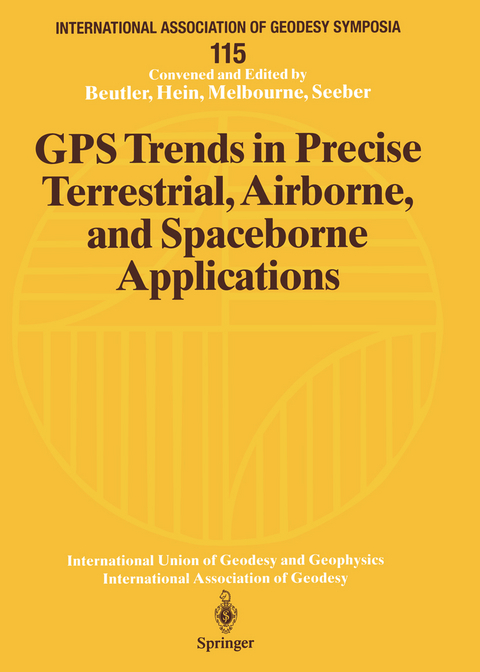
GPS Trends in Precise Terrestrial, Airborne, and Spaceborne Applications
Springer Berlin (Verlag)
978-3-540-60872-1 (ISBN)
1 The International GPS Service for Geodynamics (IGS) and other Permanent Networks.- The International GPS Service for Geodynamics (IGS): The Story.- IGS Combination of Precise GPS Satellite Ephemerides and Clocks.- Global GPS Data Flow from Station to User within the IGS.- Global Plate Kinematics Estimated by GPS Data of the IGS Core Network.- The Impact of IGS on the Analysis of Regional GPS-Networks.- Variation in EOP and Station Coordinate Solutions from the Canadian Active Control System (CACS).- Common Experiment of the Analysis Centre CODE and the Institute of Geodesy and Geodetic Astronomy of Warsaw University of Technology (IGGA WUT) on the Combination of Regional and Global Solutions.- Using GPS to Determine Earth Orientation.- The Permanent GPS Station at the University of Padova.- Analysis of Continuous GPS Observations for Geodynamics Purposes.- The Western Canada Deformation Array: An Update on GPS Solutions and Error Analysis.- The DGPS Service for the FRG: Concept and Status.- Status of the Brazilian Network for Continuous Monitoring of GPS (RBMC).- Weekly-Arc Approach to Improve the Resolution of the Long-Term Crustal Movements in Japanese GPS Fixed-Point Network.- Unification of Regional Vertical Datums Using GPS.- GPS Derived Displacements in the Azores Triple Junction Region.- Application of GPS Kinematic Method for Detection of Crustal Movements with High Temporal Resolution.- 2 Spaceborne Applications of the GPS.- Spaceborne GPS for Earth Science.- TOPEX/Poseidon Precision Orbit Determination with SLR and GPS Anti-Spoofing Data.- TOPEX/Poseidon Precision Orbit Determination Using Combined GPS, SLR and DORIS.- Observations of TOPEX/POSEIDON Orbit Errors Due to Gravitational and Tidal Modeling Errors Using the Global Positioning System.- PreliminaryResults from the GPS/MET Atmospheric Remote Sensing Experiment.- Initial Results of GPS-LEO Occultation Measurements of Earth's Atmosphere obtained with the GPS-MET Experiment.- The Laser Retroreflector Experiment on GPS-35 and 36.- 3 Kinematic Applications of the GPS.- Kinematic GPS Trends - Equipment, Methodologies and Applications.- Kinematic and Rapid Static (KARS) GPS Positioning: Techniques and Recent Experiences.- Developments in Airborne 'High Precision' Digital Photo Flight Navigation in 'Realtime'.- High Precision Deformation Monitoring Using Differential GPS.- Multi-Sensor Arrays for Mapping from Moving Vehicles.- Testing of Epoch-by-Epoch Attitude Determination and Ambiguity Resolution in Airborne Mode.- Experiences in DGPS/DGLONASS Combination.- Precise DGPS Positioning in Marine and Airborne Applications.- Developments in Real-Time Precise DGPS Applications: Concepts and Status.- A Kinematic GPS Survey at the Northern Part of Kagoshima Bay, Japan.- GPS Kinematic Real-Time Applications in Rivers and Train.- Testing High-Accuracy, Long-Range Carrier Phase DGPS in Australasia.- 4 The GPS and its Relations to Geophysics.- Using the Global Positioning System to Study the Atmosphere of the Earth: Overview and Prospects.- On Atmospheric Effects on GPS Surveying.- About the Use of GPS Measurements for Ionospheric Studies.- Assessement of two Methods to Provide Ionospheric Range Error Corrections for Single-Frequency GPS Users.- Deriving Ionospheric TEC from GPS Observations.- Mitigation of Tropospheric Effects in Local and Regional GPS Networks.- GPS as a Location Tool for Electromagnetic Surveys.- 5 Theory and Methodology.- Size and Shape of L1/L2 Ambiguity Search Space.- Integer Ambiguity Estimation with the Lambda Method.- The Impact of AmbiguityResolution on GPS Orbit Determination and on Global Geodynamics Studies.- On-The-Fly Ambiguity Resolution for Long Range GPS Kinematic Positioning.- GPS Phases: Single Epoch Ambiguity and Slip Resolution.- Direct Ambiguity Resolution Using Integer Nonlinear Programming Methods.- Alternative Forms of GPS Adjustment Models with Kalman Gain Matrices.- Status of the GEOSAT Software after Ten Years of Development and Testing.- Analysis of Data from the VLBI-GPS Collocation Experiment CONT94.- A New Software for GPS Data Processing. Work in progress and preliminary results.- Low-cost GPS Time Synchronization: The "Totally Accurate Clock".- Characterizations of GPS User Antennas: Reanalysis and New Results.- Azimuth-and Elevation-Dependend Phase Center Corrections for Geodetic GPS Antennas Estimated from GPS Calibration Campaigns.
| Erscheint lt. Verlag | 17.4.1996 |
|---|---|
| Reihe/Serie | International Association of Geodesy Symposia |
| Zusatzinfo | XIII, 338 p. 34 illus. |
| Verlagsort | Berlin |
| Sprache | englisch |
| Maße | 193 x 270 mm |
| Gewicht | 785 g |
| Themenwelt | Naturwissenschaften ► Geowissenschaften ► Geografie / Kartografie |
| Naturwissenschaften ► Geowissenschaften ► Geologie | |
| Naturwissenschaften ► Geowissenschaften ► Geophysik | |
| Technik ► Bauwesen | |
| Schlagworte | Geodesy • Geodynamics • Geodynamik • Navigation • Orbit • Remote Sensing • Satellite • satellite geodesy • Satellitengeodäsie • Surveying • Überwachung |
| ISBN-10 | 3-540-60872-9 / 3540608729 |
| ISBN-13 | 978-3-540-60872-1 / 9783540608721 |
| Zustand | Neuware |
| Haben Sie eine Frage zum Produkt? |
aus dem Bereich


